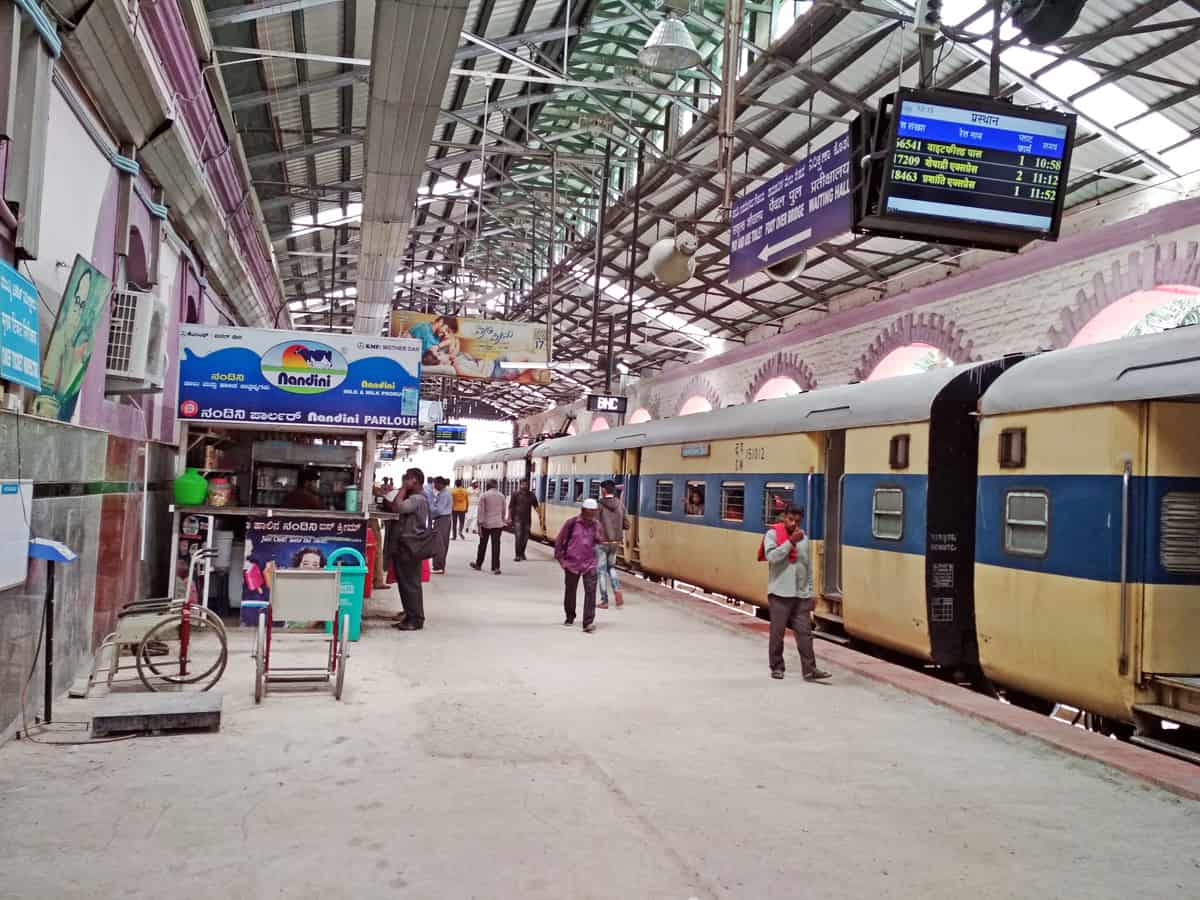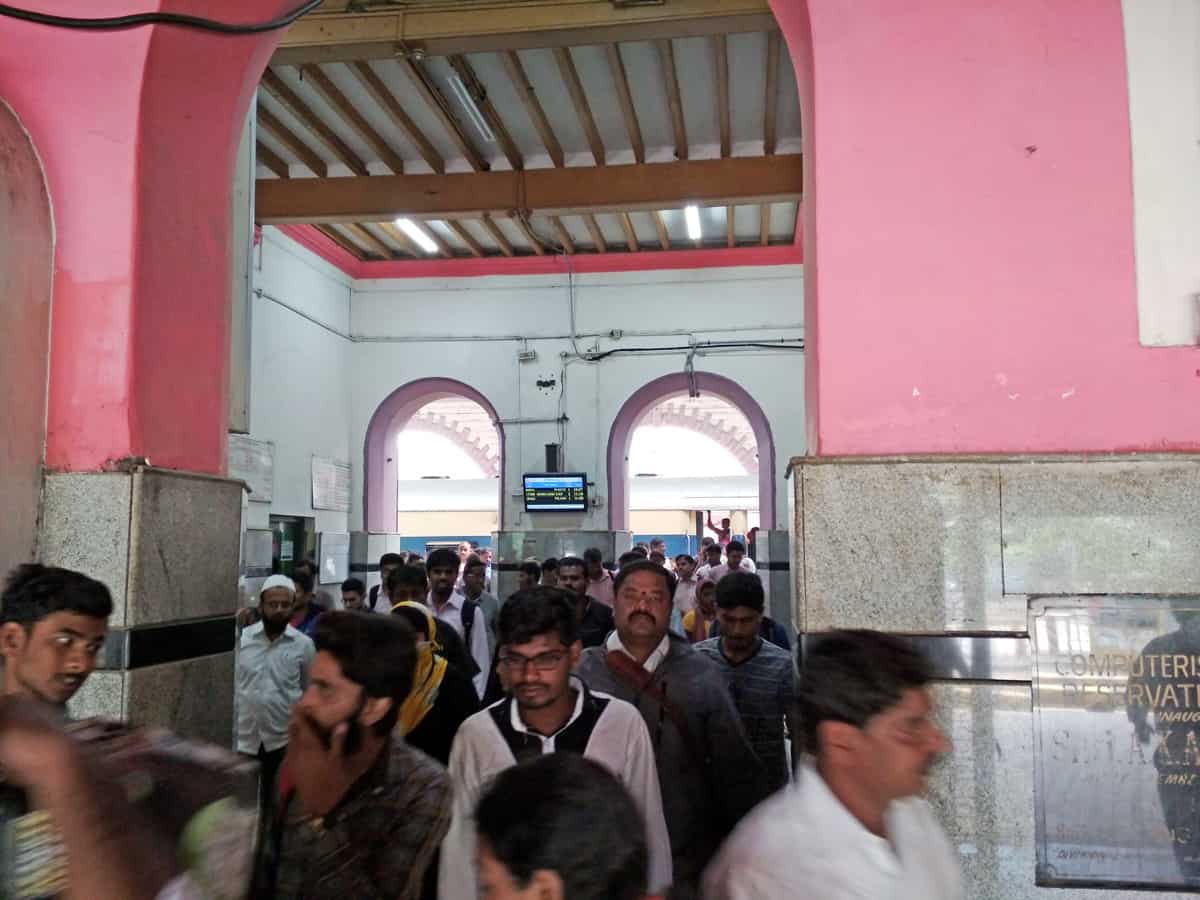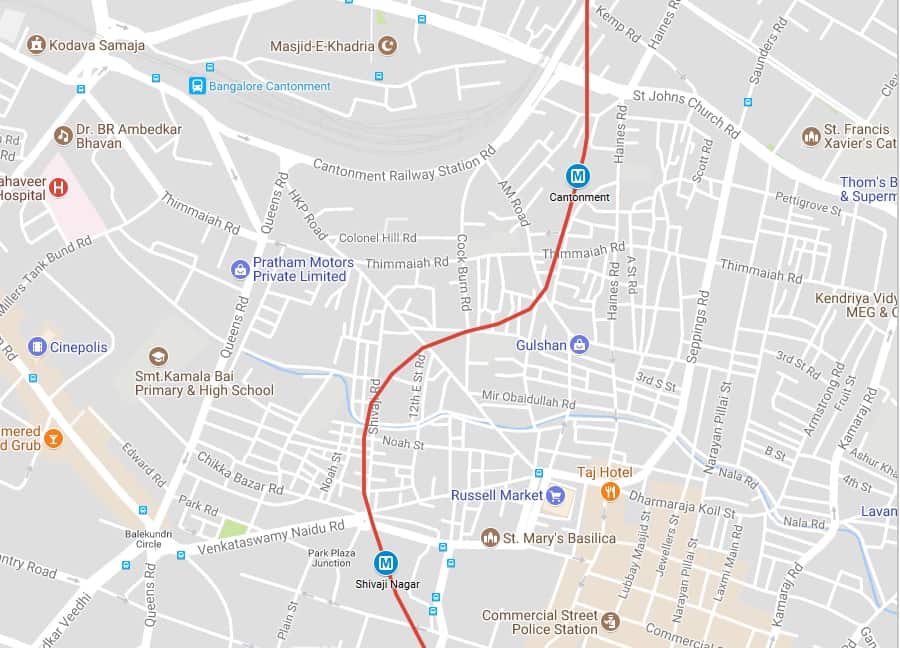The decision of Bengaluru Metro Rail Corporation Limited (BMRCL) to relocate the Cantonment Metro station has drawn flak from citizens. Why has this become such a big issue? The answer is something every urban transport planner will appreciate, every concerned citizen will appreciate, and every visionary will appreciate. Those who don’t, will appreciate it the moment they become aware of its implications in their daily lives. The answer is, integration.
What went wrong?
Metro is here for the next several decades from now–our next few generations will use the Metro to move around this sprawling, ever-expanding city. If Metro is isolated, is made without proper public consultation, without transparency, they will suffer, and probably wonder what we were up to! The Phase I with all its issues is completed and done, as far as BMRCL is concerned. But Phase-II has not yet really started. Do we repeat mistakes, or learn from them, and correct ourselves?
Suddenly, in mid-June 2017, media reports stated that BMRCL, a joint venture special purpose vehicle of the State and Union governments, decided to shift the Cantonment Metro Station from its approved location to a playground in Bamboo Bazaar near Shivajinagar, citing the delay in getting land from the railways and the availability of the playground from BBMP free of cost, as the reasons. This came as a rude shock to citizens, who had to grope in the dark without much detail put out in public.
The reasons and their validity
After media reports, the South Western Railway (SWR) came out with a press release on 24 June 2017, that said they were ready to co-operate for integration with Metro. After this, BMRCL stopped blaming the Railways, but came out with a new line–the shift was only 250m! Anybody who knows the locality will straight-away reject this. Using Google maps, we found that the distance was not 250 metres, as claimed repeatedly by BMRCL, but 1.5kms to go to the playground from Cantonment Railway Station Main Entrance and 1.8kms to return.
When this was highlighted, BMRCL came out with another angle–the distance was not by road, but by a skywalk they intend to make from the playground to the railway Station. Even this was a lie. Again, Google showed a straight line (which is the shortest distance between two points) from the centre of the playground to the centre of the length of the platform was 800 metres. So, where did the 250m come from?
Now, BMRCL said the distance is from the playground to the nearest end of the platform, not the centre. Even that turned out to be almost 500m.
What’s wrong with distance?
Let us remember, the train stops on the platform along its length, and people will have to still add the length of the platform from their coach to the end of the platform, and the platform itself is 600m long!

Cantonment Railway station. Pic: Shiva Keshava
One thing has now become crystal clear–a commuter who gets off at the Metro opposite the Cantonment Railway Station, will have to walk an average distance of only 80 metres to get to the train coach, whereas if the metro station is shifted to the playground, the minimum walk will be 800 metres.
When these were highlighted by the media, BMRCL came up with a clutch of new techno-commercial reasons for the shift. The length of the alignment, the curvature, the depth, the cost and the travel time would all come down, and that is why they have decided to shift the Cantonment Metro Station.
These are all untenable reasons. World-over, metros try to do whatever possible to integrate with other modes of transport. The curvature and depth they are talking about are already being done globally, and BMRCL has enough resources and experience to handle these aspects.
Also, showing reduction in cost and travel time by reducing length of the alignment is no big deal. This is like converting a 100m race into an 80m race–absolute lack of sportsmanship. The integration with railways brings in benefits which are not easily quantifiable.
Also, what about the additional capital and operational expenditures to make a skywalk or a tunnel with travelator as claimed by BMRCL? What about the average 15 minutes spent by every single commuter to move between the two stations by any means? What matters the most – the man-hours lost on account of this shift, or the one minute per train saved in travel time between Gottigere and Nagavara? The same time of one minute can be easily saved by increasing the speed of the Metro trains by just 2 kmph.
What about the cost to every commuter who decides to move between the two stations by road, by auto, cab or bus? What about the loss of over Rs.1000 crores on account of each year’s delay already from 2014? The approved project cost is about Rs.25000 Crores and there is in-built 5% escalation per year, on account of delays. Ultimately, the citizens’ money will be spent on all these, and here, for a few hundred crores, an excellent integration opportunity, available on a platter, is being given away!
Finally, BMRCL has come up with a social reason: We want to serve the dense population around the playground. But, why force out hundreds of children and other users of the playground? There hasn’t been a single specific demand from the people who live around the playground. Under the plan approved earlier, this playground would have three Metro stations within 1 km radius – Pottery Town, Cantonment and Shivajinagar bus stand. If the Metro station is shifted to the playground, we will have three Metro stations within 2 kms!
What can good traffic integration do?
Bengaluru faces massive traffic jams, and many issues in our daily lives are connected with it—including our time, money, health, safety, efficiency, etc. With over 65 lakh vehicles, we are already at one vehicle for every two persons–and the extrapolation of this scenario is downright scary.
Excellent public transport systems with close integration between the various major modes of transport / commute at maximum possible locations are the practical solutions for this problem. The transport system of any city is the sum total of all available means of transport. Different modes of transport must complement each other, and not compete with each other. Collaboration is the key to integration.
A successfully integrated transport system is seamless, cost-effective and improves passenger experience. A non-stop and non-transfer integration can also have some benefits like unified ticketing, complementary scheduling of services, and fare concession on using different modes. Good integration encourages commuters to take up public transport giving up private transport. It also leads to quicker evacuation of commuters, reduction in traffic on the roads, reduction in general pollution, carbon emissions, greenhouse gas emissions, and is generally environment-friendly.
Cantonment station and integration
The Cantonment Railway Station is one of the oldest in Bengaluru, and the third busiest railway station after City Railway Station and Yesvantpur Station. It has very good connectivity through bus, auto and cab services, from all directions. A good road network around the station as well as good parking add to the comfort level of the users, leading to daily average footfalls of almost 40,000 at present.
The deciding authorities–from both state and union governments–approved a Metro Station under the parking area (opposite to the main entrance of Cantonment Railway Station) way back in 2014. In their wisdom, they considered all factors–technical and commercial–before deciding to approve the same.
At the Cantonment Railway Station, the degree of integration achievable would be far better than what has been achieved at City Railway Station and Yesvantpur. Cantonment is an opportunity for an almost in-house integration with the Railways, the upcoming Suburban Train System, BMTC bus services, autos, cabs.

People coming out of Cantonment Railway station. Pic: Shiva Keshava
Also, the Metro line passing through Cantonment Railway Station from Gottigere (near IIM, Bannerghatta Road) to Nagavara (this line is called Phase II, Reach 6), would continue to the Airport. Passengers getting in at the Airport would be able to get off at the Cantonment and walk to catch trains to Mysuru, Bangarpet, etc. in the shortest time, without adding to the road traffic.
The footfalls at the Cantonment are bound to go up drastically from the present 40,000, with the Metro Station integrated here, on account of Suburban Trains and Airport connectivity. In addition, thousands of people who commute to various offices, hostels and educational institutions located in this area will be benefited.
No public consultation by BMRCL
When we did a survey at the Cantonment Railway Station and the playground, we could not find a single person who said the decision of BMRCL was correct. In fact, the users of the playground protested on 27 August 2017, under a banner “Save Our Playground”. The people who use the Cantonment Railway Station were unanimously against the Shift.
Surprisingly, the latest document of BMRCL (BMRCL EIA of R6 dt. Aug 2017) to the Lending Banks of Europe continues to state that the Cantonment Metro Station will be integrated with the Railway Station and will be situated under the Parking Area outside the Railway Station. However, the website of BMRCL (http://english.bmrc.co.in/) does show the Cantonment Metro Station at the Playground, but is silent on the reasons.

The new position of Cantonment station. Map courtesy: The Metro Rail Guy
All the reasons were given out to the Media by the Managing Director of BMRCL, Pradeep Singh Kharola. No one else in BMRCL is authorised to speak on the matter. So, we went to meet him. He was adamant. We asked him who took this decision, and were aghast to note that there was no public demand, no public consultation at all on such an important matter. It was an in-house decision! Is this how BMRCL works ? Is this how the citizens want it to work? Is this how our elected representatives will allow BMRCL to work? If BMRCL has a Board / committee to take such decisions, are counter-views considered? Did anyone present the benefits of retention of Cantonment Metro Station where it was approved? Can an approval granted by State and Union governments be allowed to be reversed like this by BMRCL? Is there any hidden reason or hand behind this shift, which is not yet out in the public domain ?
These and many other similar questions beg answers–answers being asked by the affected millions of this city, who want this wrong decision reversed immediately. In a democracy, the views of citizens must be taken into consideration. And, more so, in this case, if BMRCL really wants us to continue calling this project as Namma Metro.
What’s the solution?
What is the Ideal solution in this situation?
(1) BMRCL must immediately reverse its wrong decision to shift the Cantonment Metro Station from its approved location
(2) BMRCL must work for world-class integration with the Railways at this Station
(3) BMTC must provide excellent feeder services to the people surrounding the playground to the three Metro Stations they will have within 1km radius
(4) BBMP must improve the locality around the playground in every possible manner, in consultation with the local population.
The question that arises then is, is there any underhand benefit that someone is getting? Either at BMRCL, BBMP or Karnataka govt?
The reason for such a change is nothing but the ease of BMRCL in getting it completed. For the MD only the date of completion matters. And he will not admit they made a mistake
Even though Cantonment Railway Station is the first to connect outside the Mysore State (with
Madras ) by MSM Railways during the British Raj, it got step motherly treatment in Karnataka. There is no direct City bus connectivity from most of the suburbs even today. Neither any upcountry trains start from there. Most of the new trains start from Yashvanthpur which is far away from the City. The Government and the regional transport authorities like BMRCL,BMTC, KSRTC are more concerned about connecting Bangalore Airport with more transport facilities !
It is simple logic that BMRCL station should be in the Railway Station itself or nearby location for the commuters change over easily.
I hope BMRCL will pick a spot nearer to the Station for their connectivity.
A very good detailed note is published by Citizen Matters on September 20,2017 on the wrong proposal by BMRCL about alternate location of Metro station near Cantonment Railway Station. The alternate proposal is to locate the Metro station at the playground in Bamboo Bazar near Shivajinagar. All aspects are considered in the note which BMRCL has to consider.
I have examined the sites for alternate location in the area around Cantonment Railway station. There are vast open spaces at the following points
1. To the east of Kodava Samaja where some slum people locate tents now and then.
2. The Railways playground in Vasanthnagar facing Miller Road is not being used to the extent required. This playground area may be considered as one of the alternate sites.
3. Vast open areas are available to the south of the road from the Cantonment Station to Queens Road.
4. Vast open space is available in the Veterinary services Hospital premises on the north of the Hospital.
5. Parts of Miller Tank area was allotted by BBMP to various Institutions at nominal rates by the BBMP. The parties who are allotted are Institutions, private trusts like Jain Hospital who have misused the land for building commercial complex etc, some automobile garages, etc. The alternate site for Metro station may also be examined in this area of Miller tank and required area taken back from the allottees.
6. There are vast open spaces in the Jaymahal Palace compound owned by private parties where a hotel is located.
7. Offices of the Railways on Miller Road behind Cantonment Railway station have vast open areas which may be utilized by shifting the offices to a multistoried building in the same premises.
A google map extract showing the locations suggested by me is enclosed
The authors of the note prepared by Citizen Matters may kindly examine the above locations suggested by me.
-Dr. A. S. Kodanda Pani,
Urban Planner & Civic Analyst
The right question to ask is: Why do we need Cantonment Railway station?
Just like Bengaluru East station is no longer prominently used, Cantonment station should also be abandoned. Yeshwantpur, Majestic and Byappanahalli (still being developed) can be the 3 major train terminals for the city. Byappanhalli because there is space and the Yelahanka and Hosur lines junction with the East bound main railway line here.
Having too many stops within the city is classic feudal Indian attitude, where the benefit of a few, harms the interests of the many. Long distance trains add 10-15 minutes to their running train because of unnecessary stops like Cantonment.
Balaji, Cantonment Railway Station was the first Railway Station in Bengaluru and the Railways have big plans to develop it into a major hub – although there is not much done yet. I am surprised you are comparing it with East. Please note that at present the average daily footfalls at Cantonment are about 60000, and growing. Recently suburban trains have begun operation from Cantonment. There is good bus, auto connectivity from here and good parking area and broad roads all around. The question at present is not whether Cantonment railway station should be used, it is about whether the Metro Station should be close to the Main Entrance (as approved by both State and Union Governments) or to a Playground situated 1.5kms by road. If we do not oppose this wrong decision of BMRCL, they will go ahead and make it in the playground and we will have no answers to our next generation who will question us !!